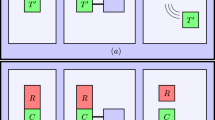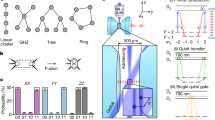Abstract
Quantum entanglement is the central resource behind quantum information science, from quantum computation and simulation1,2 to enhanced metrology3 and secure communication1. These applications require the quantum control of large networks of qubits to realize gains and speed increases over conventional devices. However, propagating entanglement becomes difficult or impossible as the system grows in size. Here, we demonstrate the first step in a modular approach4 to scaling entanglement by using complementary quantum buses on a collection of three atomic ion qubits stored in two remote ion trap modules. Entanglement within a module is achieved with deterministic near-field interactions through phonons5, and remote entanglement between modules is achieved with a probabilistic interaction through photons6. This minimal system allows us to address generic issues in the synchronization of entanglement with multiple buses. It points the way towards a modular large-scale quantum information architecture that promises less spectral crowding and thus potentially less decoherence as the number of qubits increases4. We generate this modular entanglement faster than the observed remotely entangled qubit-decoherence rate, showing that entanglement can be scaled simply by adding more modules.
This is a preview of subscription content, access via your institution
Access options
Subscribe to this journal
Receive 12 print issues and online access
$259.00 per year
only $21.58 per issue
Buy this article
- Purchase on SpringerLink
- Instant access to full article PDF
Prices may be subject to local taxes which are calculated during checkout




Similar content being viewed by others
References
Nielsen, M. A. & Chuang, I. L. Quantum Computation and Quantum Information (Cambridge Univ. Press, 2000).
Quantum simulation. Nature Phys. 8, (Insight issue) 263–299 (2012).
Giovannetti, V., Lloyd, S. & Maccone, L. Quantum metrology. Phys. Rev. Lett. 96, 010401 (2006).
Monroe, C. et al. Large scale modular quantum computer architecture with atomic memory and photonic interconnects. Phys. Rev. A 89, 022317 (2014).
Blatt, R. & Wineland, D. J. Entangled states of trapped atomic ions. Nature 453, 1008–1015 (2008).
Duan, L-M. & Monroe, C. Colloquium: Quantum networks with trapped ions. Rev. Mod. Phys. 82, 1209–1224 (2010).
Isenhower, L. et al. Demonstration of a neutral atom controlled-NOT quantum gate. Phys. Rev. Lett. 104, 010503 (2010).
Wilk, T. et al. Entanglement of two individual neutral atoms using Rydberg blockade. Phys. Rev. Lett. 104, 010502 (2010).
Dolde, F. et al. Room-temperature entanglement between single defect spins in diamond. Nature Phys. 9, 139–143 (2013).
Dicarlo, L. et al. Preparation and measurement of three-qubit entanglement in a superconducting circuit. Nature 467, 574–578 (2010).
Neeley, M. et al. Generation of three-qubit entangled states using superconducting phase qubits. Nature 467, 570–573 (2010).
Kielpinski, D., Monroe, C. & Wineland, D. J. Architecture for a large-scale ion-trap quantum computer. Nature 417, 709–711 (2002).
Barrett, M. et al. Deterministic quantum teleportation of atomic qubits. Nature 429, 737–739 (2004).
Cirac, J. I., Zoller, P., Kimble, H. J. & Mabuchi, H. Quantum state transfer and entanglement distribution among distant nodes in a quantum network. Phys. Rev. Lett. 78, 3221–3224 (1997).
Duan, L-M., Lukin, M. D., Cirac, J. I. & Zoller, P. Long-distance quantum communication with atomic ensembles and linear optics. Nature 414, 413–418 (2001).
Moehring, D. L. et al. Entanglement of single-atom quantum bits at a distance. Nature 449, 68–71 (2007).
Nölleke, C. et al. Efficient teleportation between remote single-atom quantum memories. Phys. Rev. Lett. 110, 140403 (2013).
Pfaff, W. et al. Unconditional quantum teleportation between distant solid-state quantum bits. Science 345, 532–535 (2014).
Matsukevich, D. N., Maunz, P., Moehring, D. L., Olmschenk, S. & Monroe, C. Bell inequality violation with two remote atomic qubits. Phys. Rev. Lett. 100, 150404 (2008).
Olmschenk, S. et al. Manipulation and detection of a trapped Yb+ hyperfine qubit. Phys. Rev. A 76, 052314 (2007).
Simon, C. & Irvine, W. T. M. Robust long-distance entanglement and a loophole-free Bell test with ions and photons. Phys. Rev. Lett. 91, 110405 (2003).
Olmschenk, S. et al. Quantum teleportation between distant matter qubits. Science 323, 486–489 (2009).
Sackett, C. A. et al. Experimental entanglement of four particles. Nature 404, 256–259 (2000).
Chwalla, M. et al. Precision spectroscopy with two correlated atoms. Appl. Phys. B 89, 483–488 (2007).
Mølmer, K. & Sørensen, A. Entanglement and quantum computation with ions in thermal motion. Phys. Rev. A 62, 022311 (1999).
Lee, P. J. et al. Phase control of trapped ion quantum gates. J. Opt. B 7, S371–S383 (2005).
Inlek, I. V., Vittorini, G., Hucul, D., Crocker, C. & Monroe, C. Quantum gates with phase stability over space and time. Phys. Rev. A 90, 042316 (2014).
Schmidt, P. O. et al. Spectroscopy using quantum logic. Science 309, 749–752 (2005).
Barret, M. D. et al. Sympathetic cooling of 9Be+ and 24Mg+ for quantum logic. Phys. Rev. A 68, 042302 (2003).
Briegel, H-J., Dürr, W., Cirac, J. I. & Zoller, P. Quantum repeaters: The role of imperfect local operations in quantum communication. Phys. Rev. Lett. 81, 5932–5935 (1998).
Kómár, P. et al. A quantum network of clocks. Nature Phys. 10, 582–587 (2014).
Pelc, J., Langrock, C., Zhang, Q. & Fejer, M. Influence of domain disorder on parametric noise in quasi-phase-matched quantum frequency converters. Opt. Lett. 35, 2804–2806 (2010).
Hayes, D. et al. Coherent error suppression in multiqubit entangling gates. Phys. Rev. Lett. 109, 020503 (2012).
Acknowledgements
We thank K. R. Brown, L-M. Duan, J. Kim, P. Kwiat, D. N. Matsukevich, P. Maunz, D. L. Moehring, S. Olmschenk and P. Richerme for helpful discussions. This work was supported by the Intelligence Advanced Research Projects Activity, the Army Research Office MURI Program on Hybrid Quantum Optical Circuits, and the NSF Physics Frontier Center at JQI.
Author information
Authors and Affiliations
Contributions
D.H., I.V.I., G.V., C.C., S.D., S.M.C. and C.M. all contributed to the experimental design, construction, data collection and analysis of this experiment. All authors contributed to this manuscript.
Corresponding author
Ethics declarations
Competing interests
The authors declare no competing financial interests.
Rights and permissions
About this article
Cite this article
Hucul, D., Inlek, I., Vittorini, G. et al. Modular entanglement of atomic qubits using photons and phonons. Nature Phys 11, 37–42 (2015). https://doi.org/10.1038/nphys3150
Received:
Accepted:
Published:
Issue date:
DOI: https://doi.org/10.1038/nphys3150
This article is cited by
-
Realization of a crosstalk-avoided quantum network node using dual-type qubits of the same ion species
Nature Communications (2024)
-
Quantum networks with neutral atom processing nodes
npj Quantum Information (2023)
-
A high-fidelity quantum matter-link between ion-trap microchip modules
Nature Communications (2023)
-
Optically heralded microwave photon addition
Nature Physics (2023)
-
Numerical investigation of a segmented-blade ion trap with biasing rods
Applied Physics B (2023)



